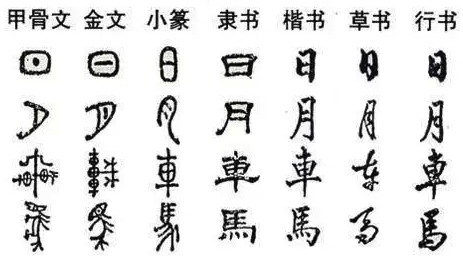Hanzi History


"The Evolution of Chinese Characters: A Timeline of Key Developments"
The process of forming Chinese characters through combination is ongoing and has evolved over millennia, the periods below provide a general timeline for significant developments in Chinese character formation.
Shang Dynasty (c. 1600-1046 BCE)
- Oracle Bone Script: The earliest known Chinese characters, inscribed on bones and turtle shells for divination purposes, were primarily pictographic and ideographic.
Zhou Dynasty (c. 1046-256 BCE)
- Bronze Script: Characters started to evolve into more abstract forms. The use of compound characters began to appear more frequently during this period.
Warring States Period (c. 475-221 BCE)
- Greater Seal Script: Characters became more standardized, and the practice of combining simpler characters to form more complex ones became more systematic.
Qin Dynasty (221-206 BCE)
- Small Seal Script: Emperor Qin Shi Huang standardized the writing system across China, leading to more consistent and uniform characters. Many compound characters we know today were formalized during this period.
Han Dynasty (206 BCE-220 CE)
- Clerical Script: This period saw further simplification and regularization of characters. Many characters, including compound ones, took forms closer to their modern appearances.
Tang Dynasty (618-907 CE)
- Regular Script: The Regular Script (楷书) became the dominant writing style. Characters were standardized in form, and the practice of creating new characters through combination continued.
Song Dynasty (960-1279 CE) and Beyond
- Development and Refinement: Characters continued to evolve in style and form. The practice of creating new characters by combining existing ones persisted, adapting to changes in society and language needs.
20th Century
- Simplified Chinese (1950s): The Chinese government introduced simplified characters to promote literacy. This involved reducing the number of strokes in many traditional characters, but the principles of character formation through combination remained.
Would you like more detailed information on a specific period or character?
汉字字体发展概览:从象形起源到现代简化的历史轨迹
汉字,作为中华文化的瑰宝,其字体的演变历经了数千年的沧桑变化。从最初的象形文字起步,逐渐发展出多种各具特色的字体类型,每一种字体都承载着特定历史时期的文化特征和审美追求。
甲骨文,作为汉字发展的起点,主要盛行于商代晚期至西周早期(约公元前14世纪至公元前11世纪)。这些文字被刻在龟甲和兽骨上,以其生动的象形形态,记录了古人对世界的认知与想象。
随后,金文在商代晚期至秦代(约公元前14世纪至公元前221年)间逐渐兴起。这些文字被铸刻在青铜器上,不仅更加规范和丰富,还反映了当时社会的高度发达和文化的繁荣。
进入春秋战国时期至秦朝(约公元前770年至公元前221年),篆书成为了重要的书写形式,包括大篆和小篆。其中,小篆作为秦朝统一后的标准字体,以其规范和统一的字形,为汉字的发展奠定了坚实的基础。
隶书则在秦朝至汉代(公元前221年至公元220年)间达到了鼎盛。这种字体在篆书的基础上进行了创新,字形由圆转变为方折,书写速度更快,更适合日常书写和官方文书的记录。
草书作为一种快速书写的字体,从东汉至唐代(约公元1世纪至10世纪)间逐渐发展壮大。草书以其连绵不断的字形和自由奔放的书写风格,成为了文人墨客表达情感和创意的重要工具。
楷书则在魏晋南北朝至唐代(约公元3世纪至10世纪)间逐渐成熟并定型。这种字体以其端正规范的字形和清晰明了的笔画,成为了后世书写的主要字体之一。
行书则介于楷书与草书之间,以其流畅自然的书写风格和兼具规范与奔放的特点,赢得了广泛的喜爱和应用。
而简体字(简化字)则是在20世纪逐渐形成并推广的。这种字体在传统繁体字的基础上进行了简化处理,使得书写更加便捷和记忆更加容易。新中国成立后,为了扫盲和提高人民文化水平,对汉字进行了大规模的简化工作,简体字因此得以广泛普及和应用。
需要注意的是,汉字字体的演变是一个连续而复杂的过程。不同字体之间并不是截然分开的,而是存在着相互影响和融合的情况。此外,汉字字体的具体演变过程和历史时期也可能因不同来源和学术观点而有所差异。但无论如何变化和发展,汉字始终承载着中华文化的精髓和民族的智慧与创造力。
